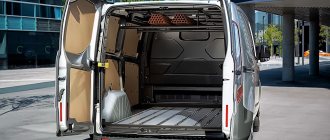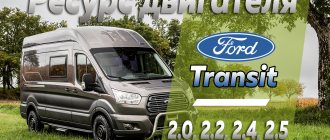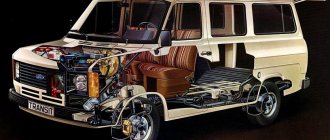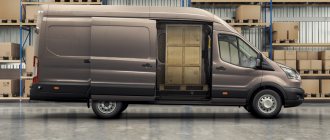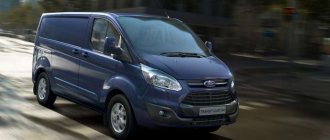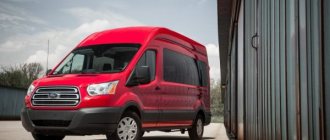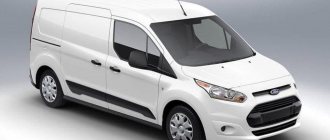Operation of the 7th generation Ford Transit (since 2006). Malfunctions, sores and shortcomings
The seventh generation of the popular representative of the Ford automaker, the 300S series, code V184/5 in the Kombi (M1) body, was released in 2006 and successfully continued the traditions of previous Transits.
Its popularity is evidenced by the fact that on its basis the VAN bus, the commercial Custom version, as well as the economical and environmentally friendly CNG version running on methane were produced. There are both front-wheel drive V347 and rear-wheel drive V348 modifications. Regardless of the fact that this Transit was produced not only in Germany itself, but also in Turkey, this did not particularly affect the build quality - no additional problems were identified with the Ford Transit. What distinguishes it from previous generations is primarily its richer equipment, which includes not only the electronic stabilization program ESP, but also the hill-start assistance system HLA. One can also note a high level of safety and maneuverability, and of course good visibility from the driver’s seat.
Engines
The Ford Transit is powered by a 2.2-litre TDCi diesel engine with 125, 136 or 155 PS outputs. Each of them is paired with a 6-speed manual transmission. The unique and innovative technical solutions used in these engines make it possible to significantly save fuel, reduce emissions of harmful substances into the atmosphere and almost instantly heat the air even at temperatures well below zero.
Peculiarities
- Individual door control
- Stowage of large cargo
- Quickclear heated windshield system
- Comfort and convenience
- Cargo compartment floor covering
The ergonomics of the Ford Transit interior are almost identical to the ergonomics of a passenger car. A variety of storage compartments and interior design options let you get things done on the go without taking your eyes off the road.
There are many options to make life easier on the road, such as:
- Height-adjustable armrest
- 8-way adjustable driver's seat
- Heated passenger seat
- Steering wheel audio controls.
- Heated driver's seat with armrest
- Height and reach adjustable steering wheel
- AM/FM audio system with AUX, USB, Bluetooth
- Electrically adjustable and heated mirrors.
The luggage compartment floor is reliably protected from dirt and damage by a durable modern coating, which also serves as sound insulation for the body. Cleaning and washing the load compartment has become much easier, as the new floor covering extends 100mm beyond the edges and prevents dirt from accumulating in the corners.
Even in very cold weather, the new Ford Transit can easily defrost the windshield and remove fog in seconds. The intelligent Quickclear system, based on ultra-fine, lightning-fast heating wires, instantly restores visibility in the van and frees the windshield wipers from ice.
The central locking system on the new Ford Transit has also been improved. Now you can remotely unlock only the driver's door, and not all at once. Only the driver can open the doors from his seat using the door switch. In addition, in some modes, this device can be used to control the lock of each door separately.
The Ford Transit van is designed to transport long, bulky cargo that car owners are forced to transport on the roof. Depending on the version you choose, you can carry luggage lengths of 3.04 m, 3.49 m or 4.21 m – significantly more than the previous generation models. In addition, when transporting such long luggage, there is no need to remove the full-height steel partition between the cab and the body.
By the way, since we are talking about features, within the framework of this article I would like to introduce you to such a new phenomenon as video surveillance in transport. This is a system that monitors the vehicle itself and the behavior of the driver while driving. It can detect driver fatigue and give a special sound signal. She also sees that the driver has lit a cigarette. In general, if anyone is interested, follow the link and find out more.
Disadvantages of the 7th generation Ford Transit
The most important disadvantage and drawback of the Transit VII can only be called expensive spare parts and a not entirely successful interior with cheap and creaky plastic. Not everyone will also like the lack of an armrest and the unfortunate, or rather inconvenient, location of the seat belt buckle. The button for controlling the clock and computer turned out to be just as inconvenient, and the pedals were tightly squeezed between the wheel arch and the dashboard. Many people are annoyed by the noise of the fan at high speeds and warming up the interior for too long; in winter they can only dream of an autonomous heater.
Operation and shortcomings of the engine and fuel system of the Ford Transit
Engine 2.2 TDCi Duratorg family with a power of 155 hp. It is distinguished by high reliability, trouble-free operation and good efficiency, consumption will not exceed 8 liters of diesel fuel on the highway and 12 liters in the city per 100 km. This power unit also boasts good torque, which is especially important for transporting goods. However, this very moment is possible only at high speeds, and for some reason the traction disappears at the bottom.
The disadvantages of the 2.2 TDCi include its reluctance to operate at low temperatures; in other words, it simply stalls when driving without warming up in extreme cold and instantly cools down when stopped. Therefore, in winter you have to thresh for days if you have to work around the city, and this means additional fuel costs. In addition, he turned out to be very picky about the quality of diesel fuel, the cetane number of which should be at least 50 - 51 and the amount of water in it should not be more than 200 mg/l - this is a typical drawback of most diesel cars, for example the Ford Galaxy 1.9TDI. Let me make a reservation right away that under no circumstances should you add any additives to the fuel, it will only make things worse.
I strongly recommend installing crankcase protection, which can easily be damaged due to low ground clearance. Protection from below is also needed to prevent dirt from getting onto the drive belt pulley and causing it to fail prematurely. One thing is unclear - why isn’t it installed at the factory, knowing all these nuances?
If the idle speed starts to float, it means that the EGR valve - the crankcase ventilation system - is clogged; this happens quite often.
Low and antifreeze
Engine oil is changed every 20-25 thousand kilometers; the manufacturer recommends Castrol 5W30 API CH, ACEA B5 with WSS approval - M2C-913C. If you use 5W40, the replacement time will have to be reduced to 15-20 thousand km. At a temperature not lower than -20°C, you can also use 10W40 ACEA B3, but again, the replacement time should be reduced to 15 thousand kilometers. If you use oil from another company with the same tolerances, you will have to change it after 10-15 thousand km, but in any case, do not add any additives to the oil; diesel Duratorg does not like this.
Silicate-free antifreeze specification Ford Motor craft Super Plus WSS-M97B44-D changes after five years of operation; it is an analogue of G12 in red.
And the last thing about the engine - beware of engine repairs from garage craftsmen; restoring a diesel engine after their intervention will be very expensive.
Electric Ford E-Transit: 350 km per charge
It has been known for a long time that Ford is developing a fully electric version of the Transit: I saw its prototype a year and a half ago at a large Ford presentation in Amsterdam. Apart from the conditional understanding that the appearance of the electric van will be practically no different from its diesel counterparts, it was not possible to glean any other information about the new product: it’s a big secret! Well, now all the curtains have been lifted - the electric Transit is officially presented.
To be fair, we note that electric vehicles based on Transit have been produced before: the small German company StreetScooter began converting Ford chassis with huge 20 cc booth bodies into electric vehicles back in 2022. An order of as many as two and a half thousand of these machines was intended for the German postal service Deutsche Post.
This electric truck was not built by Ford itself, but by the German company StreetScooter
I also saw one of these postal Transits in Amsterdam: the quality of the conversion left much to be desired, but the declared range of that van was as much as 200 km - more than the electric versions of the Sprinter or Crafter.
Well, the serial electric Transit promises to seriously increase this figure. It is equipped with a battery with a capacity of 67 kWh. And in the WLTP cycle, a van (with a nine-cc body) can travel up to 350 km on a single battery charge. Thanks to the 11.3 kW on-board charger, the battery can be fully charged from a regular outlet in just over eight hours. When connected to fast charging stations with a power of up to 115 kW with direct current, the time to replenish the charge from 15 to 80% will be just over half an hour.
The characteristics of the electric motor are also interesting: it seems that the new electric van is by no means a weakling. The engine produces 198 kW of peak power and 430 Nm of torque. It is interesting that the drive is carried out on the rear axle, and the rear suspension is completely new - independent. And so that such power is not used idle, in addition to the normal driving mode, energy-saving ones will also be provided.
The front panel architecture has not changed, but the screen in the center has become 12-inch
As for appearance, the main difference between the electric Transit is the grille with horizontal blue stripes at the front. In its lower part, in the center under the hatch, there is a socket with a connector for connecting the charging cable. There are slightly more changes in the cabin. The display in the middle of the central panel of the electric van has noticeably grown in size - from now on it is as much as 12 inches. Also, at the tide, where the gearbox lever used to be located, a round disc for selecting driving modes has settled, and the handbrake has become electronic and is located to the left of the steering wheel.
E-Transit can be used as a “power bank”, connecting various devices to it through an outlet in the body
It is stated that the E-Transit will be offered in 25 different versions, including all-metal vans with bodies up to 15.1 cubic meters with a load capacity of up to 1.61 tons, as well as chassis with single and double row cabs that can take on board almost two tons cargo The gross weight of the heaviest versions is 4.25 tons. For all versions, the battery and high-voltage electrical equipment will be provided with an eight-year warranty, and maintenance will need to be carried out once a year, regardless of mileage.
But the appearance of serial electric Transits will have to wait for now: orders will begin to be accepted towards the end of next year, and live cars will appear at European dealers only in the spring of 2022. As for our market, the appearance of such a complex and obviously expensive electric van in Russia is extremely unlikely.
Problems in electrical equipment of Ford Transit since 2006.
There are few shortcomings and problems in electrical equipment. Firstly, when the windshield wipers operate, their relay clicks quite loudly, and secondly, the headlights are located too low, which is why they get dirty very quickly. Well, sometimes the standard radio refuses to read CDs, and the Transit central locking does not respond to opening with a button.
Nothing can be done with the radio, unless you replace the disk, and the central locking is restored after opening with the key, these are the so-called factory glitches of the Ford Ftransit . The fuse and the washer reservoir pump are not durable; there shouldn’t be any more electrical problems.
Disadvantages of the Transit brake system
There is a design flaw in the brake system. This concerns the handbrake, which for some reason does not release the first time and, when tightened, catches the decorative trim.
The brake pads last for 40 thousand km, but they need to be replaced only with original Ford ones; non-original pads squeak and increase the braking distance. The front brake discs can withstand up to 140 thousand km, and the rear ones even more - 170 thousand km; their cost ranges around $220 for the front ones and $210 for the rear ones.
Ford Transit 2022 Specifications
comparison table
| Modification | L2H2 | L3H2 | L3H3 | L4H3 |
| Wheelbase | Average | Long | Long | Extra long |
| Roof height | Average | Average | High | High |
| GVW options | 2499 kg | 3100 kg | 3100 kg | 3500 kg |
| 3100 kg | 3500 kg | 3500 kg | 4,600 kg | |
| 3,500 kg | ||||
| Engine option: | Diesel 2.2 l, Duratorq 125 hp / 350 Nm | Diesel 2.2 l, Duratorq 125 hp / 350 Nm | Diesel 2.2 l, Duratorq 125 hp / 350 Nm | Diesel Duratorq 125 hp / 350 Nm |
| Diesel engine Duratorq 136 hp / 355 Nm. | ||||
| Transmission: | 6-speed manual transmission | 6-speed manual transmission | 6-speed manual transmission | 6-speed manual transmission |
| Drive unit: | Front | Front | Front | Rear |
| Full | Full | Full | ||
| Load capacity | 273 – 1472 kg | 615 – 1418 kg | 571 – 1,373 kg | 722 – 2127 kg |
| Volume: | 10.0 m3 | 11.5 m3 | 13.0 m3 | 15.1 m3 |
| 9.5 m3 | 11.0 m3 | 12.4 m3 | ||
| Axle load: | 1650 kg front / 1750 kg | 1650 kg Front 1750 kg | Front 1750 kg | Front 1,850 kg |
| Rear 1725 kg / 2150 kg | Rear 1725 kg / 2250 kg | Rear 1725 kg / 2250 kg | Rear wheel load 3050 kg | |
| Rear wheels: | Loner | Loner | Loner | Twin |
Dimensions of Ford Transit (minibus)
Technical characteristics of the Ford model range. Dimensions of Ford Transit: from 2550 x 2059 x 5531 to 2550 x 2059 x 5531, vehicle weight: kg, also transmission, engine characteristics and other features.
Technical characteristicsDimensions, mm
| 2.2TD 135 | 5.531 x 2059 x 2550 |
| BAS 2.2TD135 | 5531x2059x2550 |
| Base | 5531x2059x2550 |
| Base 17 places | 5531x2059x2550 |
| Combi 6 seats | 5531x2059x2550 |
| Combi 7 seats | 5531x2059x2550 |
| 8-seater station wagon | 5531x2059x2550 |
| COMBI M1 310M BAS 2.2TD125 T4 M6 FWD 8-seater | 5531x2059x2550 |
Ford Transit 2022. New generation of modern van
Operation of suspension and chassis
The suspension of the seventh Transit will not bring much pleasure; unfortunately, it is quite rigid and is not very reliable. Only stabilizers last the longest; they will have to be replaced after 80 thousand kilometers; other consumables are even shorter.
The chassis as a whole is without problems, but the spare tire was placed under the body, which is not a very good solution. If you replace the wheel, you will have to get dirty while you get it out. The service life of the wheel bearings is pleasing - 150 thousand km, not bad at all.
Other disadvantages and sores of Ford Transit
The body boasts durable paintwork, high load capacity and an effective climate control system. But there are more than enough shortcomings in the body. Firstly, the low ground clearance, as mentioned above, and secondly, the poor location of the washer reservoir in the front bumper opposite the wheel. Even in slight frosts, the liquid freezes from a headwind, so I advise you not to dilute it with water when refilling.
The sliding door lock is located very inconveniently, and the other doors open at too small an angle. The rear view mirrors do not fold tightly and are subject to shaking in the housing, which impairs visibility.
I would also like to warn you about washing your car in winter: you can wash it, but only with subsequent drying, otherwise the doors will freeze tightly and the door handles will break when you try to open them. Constant monitoring requires low-hanging air conditioning hoses, which are easily damaged, as well as constantly clogged washer nozzles.
The rear door lock and its flexible guides, which easily bend at large opening angles, are not durable. And finally, a recommendation regarding the VIN number, which is stamped on the inside of the right wheel arch next to the shock absorber strut. Over time, it simply rots, so to avoid problems with registration later, it is worth covering it with a good layer of anticorrosive.
- < Back
- Forward >
Used Ford Transit VI: when new engines are worse than old ones, and “collective farming” is almost inevitable
Transmission
Since the engine on the 6th generation Transit can be located both transversely and longitudinally (we talked in detail about modifications and numbering of generations in the first part), the gearboxes are from two families. The main “transverse” gearbox is a VXT75, five-speed, used mainly on Transit and commercial vehicles on a passenger chassis.
The “longitudinal” gearbox is most often the MT75, again five-speed. The unit is of very respectable age; it was installed on Taunus/Sierra/Scorpio. There is also a rarely seen six-speed MT82 for powerful Transits with a longitudinally mounted 2.4 engine, which is more familiar from the Land Rover Defender.
MT75 itself is considered conditionally eternal. The wear of clutches and synchronizers in the presence of oil, even with mileages of more than 500 thousand, can be minimal. In most cases, everything is in order with the bearings, although there have been cases when the howling began after 150 thousand mileage.
The gearbox is let down by the not-so-successful gear selection mechanism: since the heavy lever is located on the gearbox itself, it transmits strong noise and vibrations into the cabin. The latter worsen selectivity over time. Sometimes they install a cable drive from the seventh generation of Transits (after 2006). It is newer and has no problems with vibrations, but replacement is expensive and time-consuming.
The driveshaft and rear axle work in conjunction with the longitudinal box. The shafts are far from eternal: problems with the hinges of these Transits arose even during the warranty period, and when purchasing, you must definitely check the play.
The nominally maintenance-free rear axle is another headache for the transit driver. At light loads it does not cause much trouble, but runs over 300 thousand and “walks” along the highway at speeds of more than 130 km/h quickly disable it, especially if the clearances in the main pair are already broken and the bearings are worn out.
The weak point of the “transverse” manual gearbox is also the switching mechanism. The drive here is cable, there are less vibrations, but there are other problems. So, the cables are stretched, and the mechanism begins to jam at long runs. The first can be replaced, and the second can simply be disassembled, cleaned and lubricated. But due to the layout of the engine compartment, this process is again labor-intensive and is performed only in the event of a complete failure.
The life of the clutch can be one and a half hundred thousand kilometers, but often an earlier replacement occurs, and then the owners criticize the design with all their might. Prices for original clutch repair kits are frankly outrageous. For the transverse VXT75, a basket with a disk costs 50 thousand rubles - it’s good that there is LuK for 8 and SACHS for 16. By the way, there are at least five options for its design, there is even a design with a dual-mass flywheel for 2.0 engines, there is also a kit for the official conversion into a single-mass... In the catalogs there is a confusion traditional for Ford: it is only difficult to find cross-codes, replacements and analogues, clutch sets are incompatible with each other and release bearings... The services really do not like Ford drivers and their problems - be prepared for this.
The original clutch for longitudinal motors is more than half the price, a little less than 20 thousand rubles. True, the non-original is on average more expensive. But the flywheel is always dual-mass, at a cost of 50 thousand rubles, and it can also be replaced with a single-mass one from older engines if desired.
Motors
Theoretically, the Transit was equipped with more than a dozen engine options. But in practice, everything can be simplified to 2.0 and 2.4 diesel engines with a conventional electronic injection pump Bosch VP30/VP44 until 2002 and with Common Rail systems Bosch and Delphi - after. Modifications with a 2.3 petrol engine and a 3.2 turbodiesel are vanishingly rare. Many cars have already replaced two or three engines, because the chassis is more reliable than the engines, and with a mileage of 300-500 thousand, the cars are “put on the road” using the cheapest methods, the cheapest used units and a huge amount of “collective farming”.
Injection pump VP44
250,513 rubles
Among the general problems, we can mention the lack of a number of spare parts in mass demand: for example, oil cooler gaskets separately from the assembled part itself or connectors on pipes. The price of cooling system hoses is also high, but the quality leaves much to be desired: if the hose lasts only 120-150 thousand kilometers, and its price is 10-15 thousand rubles, then this is not the best offer. The situation is complicated by the fact that there is little non-original in some positions, and in others there is none at all. As a result, car owners are forced to use used spare parts or “collective farms”. They use harnesses, rings, silicone sealant and silicone pipes from KamAZ. Oddly enough, many solutions turn out to be more reliable than factory ones. Is it any wonder that Ford is losing popularity in the European market?
Few, even experienced servicemen, know how these families of motors are actually designated. “Thank you” to Ford marketers for the bright “names” for the public. Indexes can be difficult to find, but we did it.
So, the 2.0 engines before restyling are the D3FA/F3FA/ABFA family with a capacity of 75/86/100 horsepower, also known as Duratorq DI with a conventional electronically controlled Bosch VP30 injection pump. Since this family consists of modifications of earlier engines, mechanical fuel injection pumps from old diesel engines are installed here with minimal “collective farming”. The meaning of this action is obvious: the VP30 is by no means an example of reliability. Over time, it begins to drive chips into the nozzles and return, and sometimes causes breakdowns of the electrical part, which is assembled on exclusive elements and on a ceramic board. The pump is difficult and expensive to repair, the same can be said about the Delphi injectors that are paired with the Bosch injection pump. Especially often they try to replace the injection system on engines with 100 horsepower, where the injectors are more complex, more expensive and require a lot of registration in the electronic control unit.
Even if we leave aside the unsuccessful power system, the motors - by commercial standards - are not that reliable. In practice, a double-row timing chain often stretches after 200 thousand, and by 250-300 the engine may begin to knock. The latter, as a rule, means either wear of the upper end of the connecting rod, or runout of the rockers and camshafts. Restoration does not seem particularly difficult, but it is important to prevent the rockers and timing wedge from flying off.
Many owners note that when using relatively liquid 5W30 oils, the problem with wear of the beds and upper head is more pronounced than when using 5W40. But just as often, the problem is attributed to the habit of driving “at the moment”, with revs just above a thousand in any situation.
It is not often that a piston engine gets to the point of repair: either in the case of a very “cosmic” mileage, or after overheating (for example, due to a broken pump or a leaking heat exchanger gasket). The price of original pistons is such that you can’t help but wonder if Alpina or Porsche make them... But no - regular Motorcraft (Ford’s OEM spare parts brand) will cost you 36 thousand rubles for one (!) piston. Luckily, there is a Kolbenschmidt for £6 if you can't afford the original, but only in a repair size. Well, or you can replace the entire engine for 600 thousand, if you suddenly decide to “go for it all”.
2.4-liter engines before 2002 with indexes FXFA/D2FA/D2FB/D2FE and a power of 115/90/90 differ from two-liter engines in their displacement and the layout of attachments. The fuel pump is different - VP44, but in operation it is almost the same as VP30. In general, the problems are the same, but with additions.
The pump here is designed very poorly and often leaks, and the engine is even more afraid of overheating. The upper head of the connecting rod knocks earlier and stronger, and the connecting rod can also break at the lower head if there are overloads.
After 2002, Transit, as already mentioned, received new engines with the marketing name Duratorq TDCI. Mechanically, they are quite old, but the new intake and Delphi direct injection fuel equipment have seriously changed the balance of power.
Radiator
27,340 rubles
Engines 2.0 with a power of 115/130 hp. The FMBA/N7BA series received a modernized pump in one module with a power steering pump and an updated cooling system with two thermostats, as well as a new problematic drive belt tensioner for additional units. The turbine became with variable geometry, and in the last years of the model's production an electric actuator appeared instead of vacuum control.
The 2.4 engines of the JXFA/PHFC/H9FA/H9FB series with 115/135/140 horsepower, just like the earlier family, differ minimally in design from the 2.0, the modernization of the relatively old 2.4 series is in the same volume, the same as 2.0 engines with Common Rail.
Typically, Common Rail systems are more reliable than “simple” injection pumps with injectors, but the first generation design from Delphi did not have the most successful fuel pump: very sensitive to contamination, and even with a short-circuited “return” before warming up. As a result, in the event of the slightest wear, its products not only contaminate the injectors and settle in the tank and filters, but also enter the fuel injection pump en masse, which causes a chain reaction of wear and almost instantaneous failure after the initial problem.
In practice, injectors prescribed in the ECU are not such a big problem if you install serviceable ones from similar batches. Moreover, now injector codes can be entered even using free software with the cheapest OBD2 adapter. Moreover, you can even select codes based on the database to optimize the combustion process on injectors reconditioned outside the factory.
But problems with the fuel system do not end there. There is a very capricious EGR and an extremely polluted intake, and the turbine and piston group are much more heavily loaded, so the newer engines on the “sixth” Transit are rightfully considered less reliable and successful than the relatively older ones.
To take or not to take?
Transit rusts, breaks, but carries. It is easy to repair, but spare parts are sometimes mercilessly expensive and require replacement of an expensive part due to an elastic band weighing five grams. Catalogs are confusing, searching for analogues is difficult, and finding a good experienced craftsman is a problem.
Any commercial vehicle has an economically justified service life, and for the Ford Transit of this generation, according to reviews, it is about 150-200 thousand mileage. Cars have long passed this resource and now drive mostly with enthusiasm. Yes, there are still fans, there are decently maintained cars, and if you need a bus or van for some reason, you can look among the sixth generation Ford Transit. But just don’t try to make money from him - he’s already earned everything he could.

